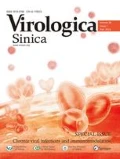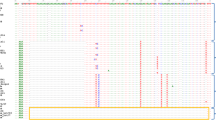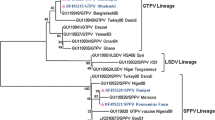Abstract
In the present study, the partial gene sequences of P32 protein, an immunogenic envelope protein of Capripoxviruses (CaPV), were analyzed to assess the genetic relationship among sheeppox and goatpox virus isolates, and restriction enzyme specific PCR-RFLP was developed to differentiate CaPV strains. A total of six goatpox virus (GTPV) and nine sheeppox virus (SPPV) isolates of Indian origin were included in the sequence analysis of the attachment gene. The sequence analysis revealed a high degree of sequence identity among all the Indian SPPV and GTPV isolates at both nucleotide and amino acid levels. Phylogenetic analysis showed three distinct clusters of SPPV, GTPV and Lumpy skin disease virus (LSDV) isolates. Further, multiple sequence alignment revealed a unique change at G120A in all GTPV isolates resulting in the formation of Dra I restriction site in lieu of EcoR I, which is present in SPPV isolates studied. This change was unique and exploited to develop restriction enzyme specific PCR-RFLP for detection and differentiation of SPPV and GTPV strains. The optimized PCR-RFLP was validated using a total of fourteen (n=14) cell culture isolates and twenty two (n=22) known clinical samples of CaPV. The Restriction Enzyme specific PCR-RFLP to differentiate both species will allow a rapid differential diagnosis during CaPV outbreaks particularly in mixed flocks of sheep and goats and could be an adjunct/supportive tool for complete gene or virus genome sequencing methods.
Similar content being viewed by others
References
Babiuk S, Bowden T R, Boyle D B, et al. 2008. Capripox viruses: An emerging worldwide threat to sheep, goats and cattle. Trans Emerg Dis, 55: 263–272.
Babiuk S, Bowden T R, Parkyn G, et al. 2009. Yemen and Vietnam capripoxviruses demonstrate a distinct host preference for goats compared with sheep. J Gen Virol, 90(Pt 1):105–114.
Balamurugan V, Danappa Jayappa K, Hosamani M, et al. 2009. Comparative efficacy of conventional and TaqMan polymerase chain reaction assays in the detection of capripoxviruses from clinical samples. J Vet Diagn Invest, 21: 225–231.
Balinsky C A, Delhon G, Smoliga G, et al. 2008. Rapid preclinical detection of sheeppox virus by a real-time PCR assay. J Clin Microbiol, 46: 438–442.
Balinsky C A, Delhon G, Afonso C L, et al. 2007. Sheeppox virus kelch-like gene SPPV-019 affects virus virulence. J Virol, 81: 11392–11401.
Bhanuprakash V, Indrani B K, Hosamani M, et al. 2006. The current status of sheeppox disease. Comp Immunol Microbiol Infect Dis, 29: 27–60.
Bhanuprakash V, Venkatesan G, Balamurugan V, et al. 2010. Pox outbreaks in sheep and goats at Makhdoom (Uttar Pradesh), India: evidence of sheeppox virus infection in goats. Transbound Emerg Dis, 57(5): 375–382.
Bhanuprakash V, Hosamani M, Singh R K. 2011. Prospects of control and eradication of capripox from the Indian subcontinent: a perspective. Antiviral Res, 91(3): 225–232.
El-Kenawy A A, El-Tholoth M S, et al. 2010. Sequence analysis of attachment gene of lumpy skin disease and sheep poxviruses. Virol Sin, 25(6): 409–416.
Fulzele S, Singh R K, Hosamani M, et al. 2006. Evaluation of Duplex PCR and PCR-RFLP for Diagnosis of Sheep Pox and Goat Pox. Int J Trop Med, 1(2): 66–70.
Gershon P D, Kitching R P, Hammond J M, et al. 1989. Poxvirus genetic recombination during natural virus transmission. J Gen Virol, 70 (Pt 2): 485–489.
Heine H G, Stevens M P, Foord A J, et al. 1999. A capripoxvirus detection PCR and antibody ELISA based on the major antigen P32, the homolog of the vaccinia virus H3L gene. J Immunol Methods, 227: 187–196.
Hosamani M, Mondal B, Tembhurne P A, et al. 2004. Differentiation of sheeppox and goatpox viruses by sequence analysis and PCR-RFLP of P32 gene. Virus Genes, 29: 73–80.
Ireland D C, Binepal Y C. 1998. Improved detection of capripoxvirus in biopsy samples by PCR. J Virol Methods, 74: 1–7.
Lamien C E, Le Goff C, Silber R, et al. 2011. Use of the Capripoxvirus homologue of Vaccinia virus 30 kDa RNA polymerase subunit (RPO30) gene as a novel diagnostic and genotyping target: development of a classical PCR method to differentiate Goat poxvirus from Sheep poxvirus. Vet Microbiol, 149(1–2): 30–39.
Mangana-Vougiouka O, Markoulatos P, Koptopoulos G, et al. 1999. Sheep poxvirus identification by PCR in cell cultures. J Virol Methods, 77 (1):75–79.
Mondal B, Hosamani M, Dutta T K, et al. 2004. An outbreak of sheeppox on a sheep breeding farm in Jammu, India. Rev Sci Tech, 23(3): 943–949.
Parthiban M, Govindarajan R, Manoharan S, et al. 2005. Comparative sequence analysis of diagnostic PCR amplicons from Indian sheeppox virus, Veterinarski Arhiv, 75 (3): 203–209.
Rao T V S, Bandyopadhyay S K. 2000. A comprehensive review of goatpox and sheeppox and their diagnosis. Anim Health Res Rev, 1(2): 127–136.
Roy P, Purushothaman V, Sreekumar C, et al. 2008. Sheeppox disease outbreaks in Madras Red and Mechery breeds of indigenous sheep in Tamilnadu, India. Res Vet Sci, 85: 617–621.
Tamura K, Peterson D, Peterson N, et al. 2011. MEGA5: Molecular Evolutionary Genetics Analysis using Maximum Likelihood, Evolutionary Distance, and Maximum Parsimony Methods. Mol Biol Evol, 28(10): 2731–2739.
Van Regenmortel M H V, Fauquet M, Bishop D H L. 2000. Virus taxonomy: Seventh Report of the International Committee on Taxonomy of Viruses. San Diego: Academic Press.
Venkatesan G, Balamurugan V, Singh R K, et al. 2010. Goatpox virus isolated from an outbreak at Akola, Maharashtra (India) phylogenetically related to Chinese strain. Trop Anim Health Prod, 42(6): 1053–1056.
Verma S, Verma L K, Gupta V K, et al. 2011. Emerging Capripoxvirus disease outbreaks in Himachal Pradesh, a northern state of India. Transbound Emerg Dis, 58(1): 79–85.
Yan X M, Chu Y F, Wu G H, et al. 2012. An outbreak of sheeppox associated with goatpox virus in Gansu province of China. Vet Microbiol, 156(3–4): 425–428.
Yeruham I, Yadin H, Van Ham M, et al. 2007. Economic and epidemiological aspects of an outbreak of sheeppox in a dairy sheep flock. Vet Rec, 160(7): 236–237.
Author information
Authors and Affiliations
Corresponding author
Rights and permissions
About this article
Cite this article
Venkatesan, G., Balamurugan, V., Yogisharadhya, R. et al. Differentiation of sheeppox and goatpox viruses by polymerase Chain reaction-restriction fragment length polymorphism. Virol. Sin. 27, 352–358 (2012). https://doi.org/10.1007/s12250-012-3277-2
Received:
Accepted:
Published:
Issue Date:
DOI: https://doi.org/10.1007/s12250-012-3277-2




